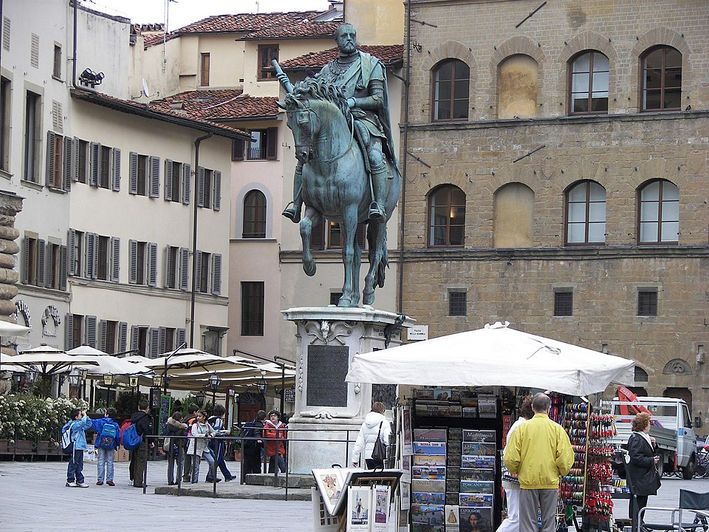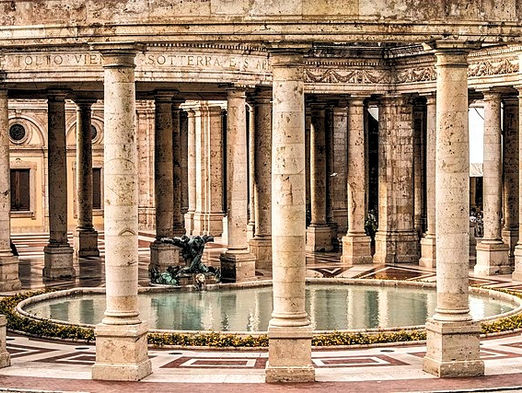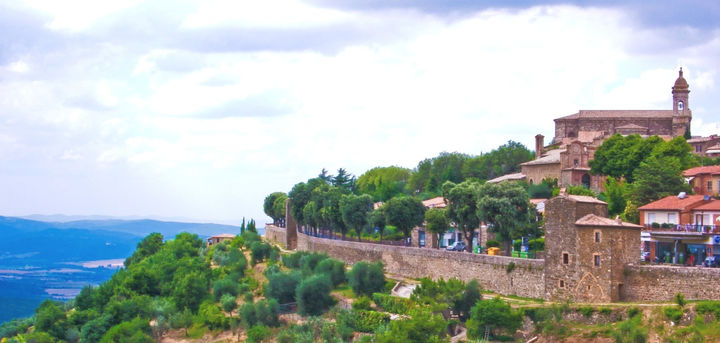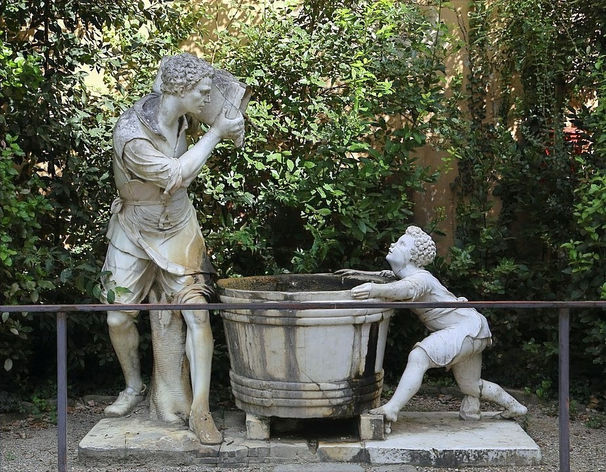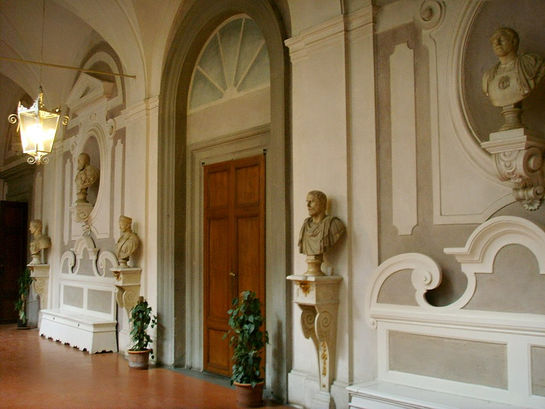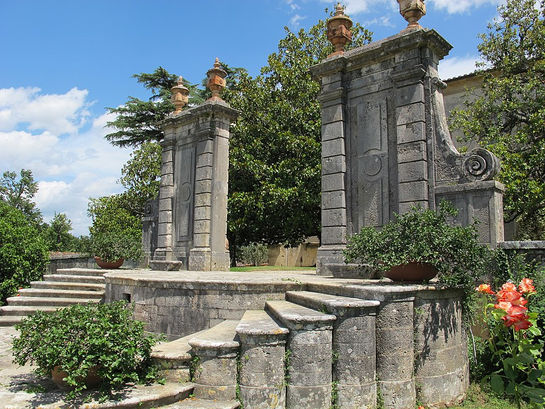
.jpeg)
Tuscany
Tuscany charms visitors with beautiful rolling landscape , acres of vineyards, olive groves, cypress trees, natural springs, history, renaissance masterpieces and world class wines. Tuscany is one of Italy's best wine-producing areas, and also produces some of the finest leather goods in the world. Don’t leave Tuscany without savoring some of its great wines!
There are seven UNESCO world Heritage Sites in Tuscany, namely:
-
Historic Centre of Florence
-
Historic Centre of San Gimignano
-
Historic Centre of Siena
-
Historic Centre of the City of Pienza
-
Medici Villas and Gardens in Tuscany
-
Piazza del Duomo, Pisa
-
Val d’Orcia
Tuscany, a land full of naturalistic wonder, artistic treasures and delicacies !
By Giuseppe Paris-wikimedia.org


Zip around the enchanting Tuscany hillside on a Vespa or driven in a vintage Fiat by an awesome guide
Visit one of the many wineries

Savor some of its great wines
paired with local Tuscan specialties
Florence
Florence is the capital of Tuscany , with countless number of renaissance masterpieces, artwork, museums,
historic churches, and fabulous statues. It is a destination for art lovers. Many of the great Italian artists such as Michelangelo or Leonardo da Vinci once lived in this city. It was declared a UNESCO World Heritage Site in 1982.
Montecatini Terme
The Italian resort of Montecatini Terme enjoys a fabulous location at the foot of the Apennines, in the picturesque Nievole valley. Montecatini is famous for its thermal waters and can be considered one of the biggest “spa towns” in Italy and has gained worldwide recognition too.
Thermal waters are the treasure of Montecatini. You can both drink the water of the Terme di Montecatini or do spa treatments - from massages to mud baths, saunas to beauty treatments.
There are nine thermal baths dot the town, offering a chance to enjoy the waters the Romans loved. One of the biggest spas in the area is the Terme di Montecatini Spa. Its building is a great example of open-air Art Nouveau that are not-to-be-missed.
Montecatini Alto is the village with medieval origins, situated on the top of the hill that dominates Montecatini Terme. It can be reached in 10 minutes with the funicular railway, which dated back to the end of the 1800s and is still intact and functional. You’ll get charming streets to enjoy and magnificent views from the hill .
Montepulciano
The walled hilltop town of Montepulciano, nestled between the Val D'Orcia and Val di Chiana, is a quintessential Tuscan medieval village, vaunting green landscapes marked by rolling hills, olives gloves, castle walls, ramparts, thermal springs and fine wine! It's famous for its Vino Nobile, a prestigious red wine of Italy.
Besides wine, there are many gems worth visiting in the area. The town is known as a "16th-century jewel" thanks to its splendid Renaissance art and architecture.
Pisa
Well known for its Leaning Tower, its accidental tilt! This is really quite a sight! Remember to pose for some artistry snapshots! It is possible to climb the top of the tower, 297 steps ....
Don't fall down!
The square is also known as Campo dei Miracoli ("Field of Miracles"), which consists of the Cathedral, the Baptistry, the Campanile (Tower), and the Monumental Cemetery . In 1987, the whole square was declared a UNESCO World Heritage Site.
Pitigliano, the "Little Jerusalem".
A quaint old village perched atop a volcanic tufo ridge, the town stands majestically at the crossroads of the valleys, with a wonderful view of the vast unspoiled Tuscany countryside. It is one of the most charming village in Italy. Known as"Little Jerusalem" of Italy, Jewish sought refuge there after the expulsion by the Papal States during the 15th century . Pitigliano, Tuscany hidden gem, off the beaten track, away from tourist crowds!
San Gimignano
San Gimignano is fondly known as ‘city of beautiful towers’ . The quaint town is famous for its medieval skyscrapers. In fact once there were 72 towers within the walls. Nowadays, there are only 14 left. It is renowned for preserving these towers that were either constructed using the Romanesque or Gothic architectural design. These towers are still standing after 700 years. The center of San Gimignano is a UNESCO listed World Heritage Site in 1990.
Saturnia
Discover the magical spring water benefits of Saturnia. Thermal water are famous for their sulphurous waters with curative and relaxing properties. It is certainly another gem of treasure in Tuscany!
Siena
Well preserved medieval city with stunning red-brick colour covering all its historic buildings and monuments.
Piazza del Campo, one of Europe’s greatest medieval squares known for its architectural beauty, where the famous Palio di Siena takes place twice a year. The historic centre of Siena has been declared by UNESCO as World Heritage Site in 1995.
Val d'Orcia
Gentle rolling hills covered in the dense vineyards, olive groves, sunflowers, wheats, cypresses, chestnut trees, walled medieval villages, ramparts, thermal springs, all of which is diffused in a tranquilly, isolated nature, this is the most enduring image of Val D’Orcia.
Since 2004, Val d'Orcia has been included in the UNESCO list of World Cultural Landscapes, the first rural area to be honored with this award. This unique countryside has retained its unspoiled beauty for centuries.
Most of the Italian best wines - the renowned Brunello di Montalcino DOCG and olive oil are produced in this fertile area.
Pienza, Monticchiello, Bagno Vignoni, San Quirico d'Orcia and Montalcino are among some of the centuries-old charming villages nested in this rural valley. Many Italians come here to escape from big city life and enjoy one of Tuscany’s most laid back villages.
Bagno Vignoni
A village located on a hill surrounded by the valley of Orcia river, in the Val D'Orcia National Park. It is famous for its thermal spring.

Piazza delle Sorgenti in Bagno Vignoni
By alefolsom -Pixabay

Bagno Vignoni
By Francesco Veronesi-flickr
Montalcino
Montalcino completely encircled by fortified walls , is home to Brunello di Montalcino, one of the world’s most famous prestigious reds.
Montalcino has remained practically unchanged over the centuries, with its 13th-century defense walls and historic center dominated by the 14th-century fortress, Rocca di Montalcino. Inside the Rocca there is also the Enoteca la Fortezza (wine shop and wine bar), which is ideal for savoring glasses of Brunello’s vintage, the DOCG wine that has made Montalcino popular throughout the world.
Old Town
Piazza del Popolo is Montalcino's main square, located downhill from the fortress. The main building in the piazza is the town hall, and its clock tower. Close to the town hall is La Loggia, a building built in the 14th and 15th centuries that consists of six rounded arches. The narrow and steep medieval streets and stone buildings are the perfect setting for a little food shopping and wine tasting.
Abbey of Sant'Antimo
Romanesque Abbey of Sant'Antimo, located in Castelnuovo dell'Abate, in the comune of Montalcino, is a beautiful and evocative abbey built in the 12th century. Now it is occupied by a community of monks of the Olivetan Benedictine order. During Mass, you can listen to the Gregorian chants singed by the monks, an experience that has no comparison elsewhere and that makes your visit to the monastery an emotional and vivid memory.
Monticchiello
Monticchiello, an ancient village which has succeeded in conserving an authentic beauty. There are still traces of the medieval fortresses, greatly contrasting the Renaissance framework of Pienza. The sturdy walls and the tower of the keep that stands on the hill are signs of the village’s intense past, a stronghold for the defence system of the Republic of Siena.

Monticchiello
By Francesco Veronesi-flickr

City Gate Porta Sant’Agata
Monticchiello
By RossanoValeri -Pixabay
Pienza
Winding country roads flanked by vineyards, olive groves and rows of cypress trees will take you to Pienza, a jewel city of the Renaissance. This charming villagelies on a hill dominates the Val d’Orcia. It was the birthplace of Pope Pius II. In 1459, Pope Pius II decided to transform the entire village, rebuilt into the ideal Renaissance town. The rebuilding was done by Florentine architect Bernardo Rossellino. The construction of Pienza started around 1459 on top of the ancient hamlet and took about four years, creating a harmonious fifteenth-century town. After the death of Pope Pius II put a stop to the urban reorganization of the new city, which has remained perfectly intact over the centuries. Pienza was included in 1996 in the list of UNESCO World Heritage Sites.
Explore Piazza Pio II, the village main square, flanked by many Renaissance buildings; the Piccolomini Palace, the Borgia Palace, the Duomo, the Town Hall (Palazzo Comunale), the Vescovile Palace , and the Ammannati Palace.
Pienza is known for its romantic streets that attract lovers, especially for Valentine's Day. The lovely streets such as Via dell'Amore (love street) and Via del Bacio (kiss street), are popular among the lover for photoshoot with the spectacular panorama of the Val d'Orcia in the background.
San Quirico d’Orcia
San Quirico d’Orcia is an ancient walled village nestled in the swirling hills, in the heart of the beautiful Val d’Orcia, halfway between Pienza and Montalcino.
Some of the monuments to visit are Collegiata dei Santi Quirico e Giulitta, main church of the village, characterized by the presence of three access portals, one more beautiful than the other. Next, the Horti Leonini , a beautiful example of an Italian garden, built in the mid-sixteenth century by Diomede Leoni.
The most photographed spots in the entire Val D'orcia is the Chapel of the Madonna di Vitaleta, a small chapel located in the rural countryside of Vitaleta, surrounded by an almost surreal landscape.
The cypress trees, a symbol of Tuscany characteristic, are the most photographed trees in Val D'orcia!

Chapel of the Madonna of Vitaleta
San Quirico d'Orcia
By alefolsom -Pixabay
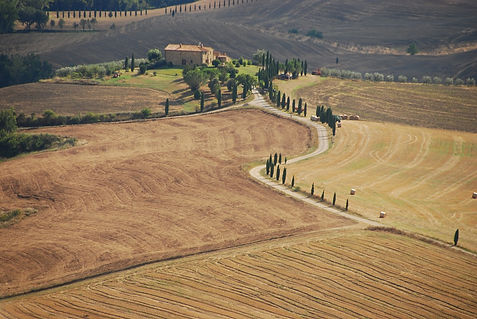
By Roberto Bellasio- Pixabay
The Medici Villas in Tuscany
The history of Tuscany is also the history of the Medici Family, one of the most powerful and richest families in Italy. This boundless richness still echoes today in the extravagant villas and gardens that this Mugellan family built during their sovereignty in Tuscany from the 15th to the 17th century.
The Medici villas are a series of rural building complexes, set in gorgeous and magnificent Tuscany. These buildings were the palaces of the Medici, scattered over the territory that they ruled, demonstrating their power and wealth. They were also recreational resorts for the leisure and pleasure of their owners and the centre of agricultural activities on the surrounding estates.
All the Medici villas have retained their original features and are excellent examples of the Florentine Renaissance and Baroque periods. In June, 2013, the Medici villas were added to UNESCO's World Heritage list.
12 villas , along with two gardens, that make up the UNESCO Site:
-
Boboli Garden (Florence)
-
Pratolino Garden (Vaglia)
-
Villa del Trebbio (San Piero, Sieve, Mugello )
-
Villa di Cafaggiolo a Barberino (Mugello)
-
Villas di Careggi (Careggi)
-
Villa la Petraia (Florence)
-
Villa Fiesole (Fiesole)
-
Villa del Poggio Imperiale (Villa of the Imperial Hil, Arcetri near Florence)
-
Villa di Poggio a Caiano (Prato)
-
Villa in Cerreto Guidi (Cerreto Guidi, near Florence)
-
Villa La Magia (Quarrata, Pistoia)
-
Villa di Artimino (Carmignano, near Prato)
-
Villa di Castello (Sesto Fiorentino, near Florence)
-
Palazzo di Seravezza (Lucca)
All of them have something that will make your visit worthwhile.
1. Boboli Gardens (Florence)
One of the most important Italian-style gardens in the world, this beautiful rises from the Florentine hills and offers views of the entire city.
A real open-air museum, boasting impressive architectures, surrounded by an incredible collection of Renaissance sculptures, bubbling fountains and landscaped to perfection.
2. Pratolino Garden
Know as “the garden of marvels”, it’s a park with artificial grottoes, water tricks and statues. The villa and the park were left empty after Francesco of Medici’s death until until it was bought by the Russian prince Paul Demidoff in the 19th century. The Villa was demolished but he restored the surrounding garden and the remaining Renaissance elements, including Giambologna’s colossal Apennines statue overlooking a small lake. A serene and relaxing setting to be explored in peace and quiet.

By Valerio Orlandini-wikimedia.org, CC BY 2.5
3. Villa del Trebbio (San Piero, Sieve, Mugello)
4. Villa di Cafaggiolo a Barberino (Mugello)
The first Medici villas , Villa del Trebbio and Villa di Cafaggiolo, both strong fortified houses built in the 14th century in the Mugello region, the original home of the Medici family.
5. Villa di Careggi (Careggi)
The villa was among the first of a number of Medici villas, notable as the site of the Platonic Academy founded by Cosimo de' Medici, who died at the villa in 1464

By Sailko-wikimedia.org, CC BY 3.0

By Sailko-wikimedia.org, CC BY 3.0
6. Villa la Petraia (Florence)
The Medici Villa della Petraia is an impressive country residence built on a panoramic terrace in the small hamlet of Castello. From its position, you have a breathtaking view over its wide Italian garden and over the valley where the famous Renaissance city of Florence is located.
The Villa della Petraia has always been used as a residence for Royalties. Medici family, the Lorraines (Leopold II) and, finally, the Savoys, Italy's royal family (Vittorio Emanuele II and his wife, Rosa Vercelliana)., the last hosts carried out a series of changes to the villa, decorating it with precious furniture, however, preserving the Renaissance elements from the Medici family.
7. Villa Fiesole (Fiesole)
The Villa Medici in Fiesole is the fourth oldest of the villas built by the Medici family. It was built between 1451 and 1457. It is one of the best preserved, but at the same time is also one of the least well known Villas. Villa Foesole has gracious terraces, vast garden, with panoramic views of the River Arno and Florence.

By Sailko-wikimedia.org, CC BY 3.0
8. Villa del Poggio Imperiale (Villa of the Imperial Hil, Arcetri near Florence)
The Medici Villa of Poggio Imperiale is located in Florence on the hills of Arcetri. The villa originally belonged to the Baroncelli family, followed by the Pandolfini and finally the Salviati, before Cosimo I de’ Medici seized the property and gifted it to his daughter Isabella, married to Paolo Giordano Orsini.
9. Villa di Poggio a Caiano (Prato)
The Medici Villa of Poggio a Caiano, also called Ambra, is one of the most famous Medici villas and is located in Poggio a Caiano (Prato). Today it is state owned and it houses two museums: one of the historic apartments and the Museum of Still Life (second floor).
10. Villa in Cerreto Guidi (Cerreto Guidi, near Florence)
Villa in Cerreto Guidi was built around 1556 on the commission of Cosimo I as a hunting residence and to be the territorial garrison near the Fucecchio Marsh, a wetland that was once rich in wild game. Now hosting the Historical Museum of Hunting.

By Sailko-wikimedia.org, CC BY 3.0

By Sailko-wikimedia.org, CC BY 3.0
11. Villa La Magia (Quarrata, Pistoia)
Originally a tower house belonging to the Panciatichi family from Pistoia in the 1300s, it passed to the Medici in 1583 when it was purchased by Grand Duke Francesco I and was renovated by the court architect Bernardo Buontalenti, There is an Italian garden, with geometric hedges and the circular fountain, and had the interiors frescoed, later, the Amati family built the limonaia and the Romantic-style park, with cypress and laurel oak woods.
12. Villa di Artimino (Carmignano, near Prato)
The Medici Villa of Artimino, also known as “La Ferdinanda”, is in the hills of Carmignano, in the little medieval hamlet of Artimino. This beautiful location, the legend says, was chosen by the Granduca Ferdinando I de’ Medici during a hunting. The main characteristic of La Ferdinanda is the sight of the many fireplaces, that’s why it is also called the "Villa dei Cento Camini", or "Villa of a hundred chimneys". Even if they are less than that number, there’s a chimney in every room, all different from one another.
%252C_veduta_13%252C.png)

By Sailko-wikimedia.org, CC BY 3.0
By Sailko-wikimedia.org, CC BY 3.0
13. Villa di Castello (Sesto Fiorentino, near Florence)
The Villa Castello is an ancient complex which boasts an elegant villa and a splendid Italian garden, second only to the Boboli Gardens in Florence.The garden was designed by Niccolò Tribolo in 1538 on commission of Cosimo of Medici and represents one of the first Italian gardens in history. This one inspired the same architect for his next creation, the famous Boboli Garden.
14. Palazzo di Seravezza (Lucca)
The Palace of Seravezza is a Medici residence commissioned by Cosimo I between 1560 and 1564 to function as a military outpost in Versilia, a highly contested territory among Florence, Lucca, Pisa and Genoa, mainly for its marble quarries.
The villa is a fortified palace that served primarily as the Grand Duke's vacation site. However, it would transform into a defensive military structure when necessary.
Today, the Villa is the seat of the “Sirio Giannini” library, the “Municipal Historical Archive” and the “Museum of Labour and Popular Traditions of Historical Versilia”. The piano nobile is reserved for important exhibitions of photography and modern and contemporary art. The stables, restored at the beginning of this century, contain the municipal theatre and cinema.

By Sailko-wikimedia.org, CC BY 3.0

By Sailko-wikimedia.org, CC NY 3.0
Truffle Hunting
Italy's real culinary treasure is the “black diamonds” or truffles found in many regions, Langhe province near the city of Alba in Piedmont , Tuscany, Umbria and Le Marche. What better way to learn about the history and art of truffle hunting than to go on a hunt yourself?
Head out into the countryside accompanied by an expert truffle hunter and his trusted dogs in search of the treasured delicacy.

By Andrea Cairone - Unsplash
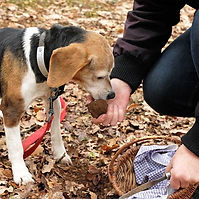
By pixelia -Pixabay






